| Title |
Format |
Summary |
|
Intended Audience |
|
"How Do I Find the Talent I Need?
Now an e-learning program Click on image below

|
E-Learning
|
Hiring Managers have to find the talent they need to get work done well. Recruiters, whether in-house or out-house, help them in that process. However, recruiting for well established roles is very different from recruiting for new ones, whether or not those new roles are in well established organizations or in new, rapidly growing ones. Insight into these differences will allow hiring managers to work more effectively with recruiters to make sure that the people they hire are the right ones. |
|
Managers who are recruiting talent. But also, candidates, who need to understand the large differences between the approach of recruiters who hire for well established roles and those of recruiters who look for people for new roles.
|
| "Recruiting is Changing: The Impact of the Internet and The Economy" |
PDF |
Changes in the economy and new tools on the Internet are changing recruiting. Today, instead of being a single professional discipline, recruiting breaks into 4 distinct types. Hiring decision makers and people looking for work as employees or contractors need to understand each, so that they can participate effectively.
|
|
Everyone, but especially leaders and professionals in talent based organizations. |
| "Go Total Talent Management or Go Bust!" |
PDF |
New talent management practices, ones which deal with the values and employment attitudes of today's talented professionals are badly needed. The practices which developed during the "baby boomer" era will simply not do the job. Total Talent Management is an integrated, aligned talent management approach which responses effectively to these challenges.
|
|
Everyone, but especially leaders and professionals in talent based organizations. |
"Hiring Talent: The Tough Job of Staffing Knowledge Work Positions" |
PDF |
What you need to do successfully hire knowledge workers (e.g. IT professional, engineers, life science professionals, etc. .... ). |
|
Business Executives in Innovative Organizations;
HR Professionals
|
| "Recruiting For Innovation" |
Voice Over
get PDF here |
Traditional recruiting techniques may work for organizations that have well established processes and practices, but they do not find the talent needed by organizations that need to be innovative. |
|
Board Members;
CEOs;
Chief Talent Officers;
C-Level Executives;
Managers;
Professionals
|
| The Right Fit: Investing in Leaders for Start Ups, Break Outs, and Turnarounds" |
Voice Over
get PDF here
| The leaders of start ups, break outs and turnarounds need different sets of competencies, since the business requirements in each situation are different. Summarizing the experience of CEOs, investors and researchers, this presentation allows hiring decision makers and professional recruiters to focus their recruiting activity appropriately.
|
| Board Members;
CEOs;
Chief Talent Officers;
Chief Human Resource Officers;
other C-Level Executives;
Managers;
Professionals
|
"Approach to Interviewing Senior Manager Candidates":
A Discussion Between Two Hiring Managers
|
Animated Video Clip
also on You Tube
|
Two peer managers about to play squash talk about how to interview a candidate for a plant manager's job. This is an example of the "in context" hiring process that provides insight into what a person will actually do on the job if the person is the successful candidate. |
|
Executives;
Professional Recruiters;
HR Recruiters
|
| "The Steep Cost of Hiring Mistakes - Avoiding Bad Hires" |
PDF |
Hiring mistakes do not just cost money, they also impact the morale and performance of co-workers. Avoiding them is possible with care and performance based hiring processes. |
|
Executives and Managers;
Recruiting professionals;
Individuals looking for new career opportunities
|
|
| "Why Performance Contracting?" |
Voice Over
get PDF here |
In less that 10 minutes, this voice over shows the organizational performance, staff engagement and motivation benefits of forward looking performance contracting as opposed to backward looking performance appraisal. "Shape the Future, Don't Appraise the Past"™ |
|
Board Members;
CEOs;
Chief Talent Officers;
Chief Human Resource Officers;
other C-Level Executives;
Managers;
Professionals
|
| "C-Level Performance Contracting: How To" |
Voice Over
get PDF here |
Understand the business benefits and the process used to develop performance contracts for C-Level Executives under the guidance of a performance contract facilitator. |
|
Board Members;
CEOs;
Chief Talent Officers;
Chief Human Resource Officers;
other C-Level Executives
|
"Performance Appraisal is Dead .. Long Live Performance Contracting"
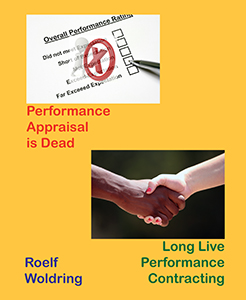
|
Voice Over
get PDF here
The Book on Amazon.com
| Forward looking performance contracting beats backward looking performance appraisal for engaging staff and motivating them to do their best. In depth benefit analysis and comparison. This voice over show why. |
|
Board Members;
CEOs;
Chief Talent Officers;
Chief Human Resource Officers;
other C-Level Executives
|
| |
| |
|
|
|
"OMG: My Boss Is Telling Me That I have To Coach My Staff"
Now an e-learning program Click on image below

|
E-Learning
|
Coaching direct reports is not a skill that just comes naturally. Staff engagement requires that all managers coach effectively. Although this happens most easily in an organization that uses forward looking performance contracting, (rather than backward looking performance appraisal,) as its performance management process, every manager can use this coaching framework to understand what skills they need to be an effective coach.
|
|
Managers with direct reports |
"Guide for "Coachees": Thing to Reflect on When Working with A Personal Coach"
|
PDF |
Coaching is a large investment in your future. Whether you are paying the coach, or your organization is, you need to understand what a coach CAN and CANNOT do to help you improve your work performance. |
|
Everyone |
| "Competency Management: HR for Adults" |
PDF |
A three part white paper which describes the competency based approach to human resource (e.g. talent) management. |
|
HR professionals;
Talent Management Professionals;
Business Managers / Executives
|
| About E-Learning and E-Learning Skill Development Programs (Go Back to Top of Page) |
| "The Know That / Know How To / Know Why Model of Knowledge" |
PDF |
This simple distinction confounds many e-learning content designers and educators. Each kind of knowing requires a different teaching / educating / coaching approach in order to be effective.
This is a one page summary clarifies these differences. Understanding them is a key element in creating effective educational content.
|
|
Everyone |
"Making Effective Decisions About Developing E-Learning Content"
Now an e-learning program Click on image below

|
E-Learning
|
Designing and developing effective e-learning content requires skills that go beyond instructional design or curriculum development. E-learning content developers must make decisions about design balances that consider variations in individual learning style, delivery program delivery technologies, graphic / media design concerns & program creation and delivery costs. This voice over, and the supporting white paper, lays out the issues and the choices.
|
|
E-Learning Developers;
Talent Management Professionals;
Instructional / Curriculum Designers;
Executives considering E-Learning options |
| E-Learning and E-Learning Skill Development Programs (Go Back to Top of Page) |
"Becoming A FeedBack Wizard"
Now an e-learning program Click on image below

|
E-Learning |
An e-learning program that uses short animated video clips and structured active exercises to allow working individuals to acquire the skills necessary to give others behavioral feedback.
The ability to give effective behavioral feedback is a core interpersonal competency needed for personal professional development and the coaching of direct reports. Few training programs exist which break this competency down into a series of manageable component skills. Everyone seems to assume that this competency just comes naturally with the movement up the career ladder to the "manager" level.
When professional professional programs do address feedback, they usually present it as a simple skill, which individuals can acquire through reading or attendance at a largely lecture based program. Few of these programs deliver more to individuals more than facts (know that) about giving behavioral feedback. As a result, feedback behavior back-on-the-job seldom changes as a result of attendance at such programs.
Giving behavioral feedback under all conditions, including ones involving stress between the two interacting individuals, is a complex competency that integrates 5 component skills. This program breaks giving behavioral feedback down into these 5 skills. It guides individuals through the steps needed to acquire each one. It concludes with a number of practice scenarios that integrate these component skills into a single competency.
The program uses short animated video clips to:
- show e-learners models of effective and ineffective feedback behaviors,
- set problem cases and short scenarios to which participants respond in order to develop their personal skills in the component behaviors.
|
|
Business Professionals |
"Becoming An Interview Wizard: An Introduction"
Now an e-learning program Click on image below

|
E-Learning Program |
Interviewing is an invaluable competency, not just for journalists and investigators, but also for working professionals and managers. The need to conduct a "conversation with purpose" for the purpose of getting needed information comes up each and every day in a working professional's life.
This voice over presentation introduces an e-learner to the basic ideas and component skills that make up the interviewing competency.
|
|
|
Business Professionals |
|
E-Learning Program |
This e-learning program dives into more depth about what it takes for you to be an effective interviewer. After completing it, you will understand:
- what interviewing is,
- what interviewing is not,
- the various business, commercial, journalistic, and investigative contexts in which interviewing is used,
- the 15 component skills used by interviewers;
- which of the 15 competent skills are used in which interviewing contexts,
- and the nature of each of the 15 component skills.
These "know that" introduction is followed by 10 "know how" e-learning sessions. Each one focuses on one of the ten component skills that are used in all interviewing situations. These ten units all use short video clips to model skilled and unskilled versions of the skills. Video clips are also used to provide learning game questions and skill development drills.
|
|
Business Professionals |
Making Decisions
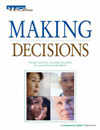
|
Competency Styles® Skill Development Workbook (Amazon.com)
|
The Making Decisions work book provides you with insight into how you behave when you make decisions by yourself and with others. After you have completed the workbook, you will have insight into your own behavior patterns, the patterns of others, and the way you interact with them in the following five behavior areas.
1. The criteria you use to make a decision when you make a decision by yourself,
2. The standards you follow when working with others to make a decision,
3. The way in which you deal with differences of opinions when making decisions with others,
4. What you do after a decision has been made in a group,
5. The way you behave personally after a decision has been finalized.
|
|
Business Professionals |
Interacting With Others
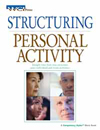 |
Competency Styles® Skill Development Workbook
(WCI Press)
Available from Roelf directly
Contact Roelf via email or get 5 packs from Amazon.com
|
The Interacting with Others work book provides you with insight into how you behave when you interact with others in one-on-one and in team situations. After you have completed the workbook, you will have insight into your own behavior patterns, the patterns of others, and the way you interact with them in the following five behavior areas.
1. The way you initiate contact and communicate with others,
2. The kind and level of energy you bring to your interactions with others,
3. How you express your ideas, emotions, interests, and feelings to others,
4. How you interact with others when in group situations,
5. The number of people with whom you maintain contact and stay involved.
|
|
Business Professionals |
Structuring Personal Activity
 |
Competency Styles® Skill Development Workbook (Amazon.com)
|
Structuring Personal Activity provides you with insight into how you behave as you structure your own work activity, and the work activities that you do with others. After you have completed the workbook, you will have insight into your own behavior patterns, the patterns of others, and the way you interact with them in the following five behavior areas.
1. The way you organize your personal work and your personal work environment,
2. The degree of structure you want in your daily activities,
3. The way you structure the smaller tasks and activities required to complete your larger projects,
4. How to be most creative when you have to meet deadlines,
5. The ways in which you structure your free time.
|
|
Business Professionals |
Gathering and Using Information
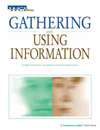 |
Competency Styles® Skill Development Workbook (Amazon.com)
|
Gathering and Using Information provides you with insight into how you behave as you process the information that you deal with each day at work. After you have completed the workbook, you will have insight into your own behavior patterns, the patterns of others, and the way you interact with them in the following five behavior areas.
1. The kind of things to which you pay attention in your perceptions,
2. How you use your perceptions and ideas to develop something new,
3. How you apply your perceptions and ideas to problems and issues,
4. How you determine what is true and construct new knowledge, 5. The social context in which you use your perceptions and ideas.
|
|
Business Professionals |
Relating Styles
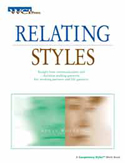
|
Competency Styles® Skill Development Workbook (Amazon.com)
|
Relating Styles is a Competency Styles® workbook that can be used by the two people in a working or life partnership. It makes no assumptions about the health or state of the relationship. It does provide both partners with insight into their personal communication and decision making behavior patterns used in the relationship. It also provides both partners insight into how their behavior patterns interact with those of the other partner.
|
|
Business Professionals |
Development Styles
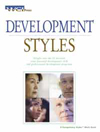 |
Competency Styles® Skill Development Workbook (WCI Press)
Available from Roelf directly
Contact Roelf to get a copy
|
Development is a Competency Styles® workbook that gives you insight into your preferred personal development activities. It helps you clarify which parts of professional development or technical training programs work best for you. It also gives you a framework for understanding your own preferred development activities and those of your subordinates if you are a manager, or your co-workers if you work in teams.
|
|
Business Professionals |
Managing Others
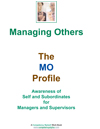 |
Competency Styles® Skill Development Workbook (WCI Press)
Available from Roelf directly
Contact Roelf to get a copy. |
Each of your subordinates is a different person. You need to assign them work, help they develop their skills and abilities, manage their performance, provide feedback on a regular basis and intervene when their performance or poor interaction with others requires it.
Most managers have very little insight into how to flex their personal behavior to maximize the effectiveness of their interaction with each of their subordinates. . We learn to manage others implicitly, during our careers, from watching other managers, and being managed ourselves. As a result, we are often unclear about the best way to work with a specific subordinate, especially when we find that some of the things that we do that work with one person does not work well with others.
"Managing Others: The MO Profile" addresses this issue. The work book gives each of us insight into the two most important behavior patterns we need to be an effective manager.
|
|
Business Professionals |
The GPS Profile: Working In Groups
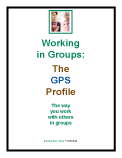
|
Competency Styles® Skill Development Workbook
(WCI Press)
Available from Roelf directly
Contact Roelf to get a copy. |
If you are like most people who work in an business environment, at least part of your day is spent working with others, either in meetings or sitting side by side with another person.
Most of us who do so have very little insight into how to optimize that work. We learn to work with others as an implicit part of growing up - starting in grade school, and going on from there. As a result, we are often unclear about the best way to work with other people, especially when we find that some of the things that we do that work with some people do not work well with others.
"Working in Groups: The GPS Profile" addresses this issue. The work book gives each of us insight into the two most important behavior patterns we take with us into all of interaction with others in groups:
- the ways in which we are verbally active (or inactive) - our verbal participation style,
- and the way we make decisions in conjunction with others - our decision making participation style.
|
|
Business Professionals |
About Information Technology, IT Architecture and Project Management (Go Back to Top of Page)
(Resources based on Roelf Woldring's many years of experience as an leader of Information Technology, IT Architecture, and Organizational Change) |
| "Learning Organizations, Work Flow and IT" |
Voice Over
get PDF here |
Organizations use a wide variety of computer business applications to do their day to day business. Automated business work flow capture and "hide" reasons for the sequence of events and reasons for decisions at particular points in this sequence in computer code. Automated business work flows are a "knowledge sink". When changes are made to the automated work flow, management and staff need to be "reminded" of the underlying business rules which have been captured in the automation code, and the reasons for change.
As a result, there is a need for a careful integration between what the IT professionals and the Talent Development / Learning Professionals in the organization are doing. Changes to business work flows need to be tightly coupled to the roll out of organizational change related learning. But this need is not well recognized, resulting in a loss of money, de-motivation and missed opportunity in most modern organizations.
|
|
Talent Management and IT Executives;
Learning / E-Learning and IT Professionals |
| "IT Project Risk Management Framework" |
Voice Over
get PDF here |
A framework which can be used to assess the risk factors in individual projects. As well, it can be used to look at the comparative risk versus the business benefits profile of all of the current projects that are underway in an enterprise.
This item has been accessed over 500 times on SlideShare.
|
|
IT Professionals;
Business Professionals involved in Projects |
| "The Organization Structure Needed to Make Enterprise Architecture Work In Large IT Organizations" |
Voice Over
get PDF here |
Enterprise architecture (EA) can have tremendous bottom line payoff for large organizations. But implementing enterprise architecture, especially over a number of years, is not easy. The Enterprise's organization structure must set up to allow this to happen effectively. Without this, enterprise architecture simply does not deliver business benefits.
|
|
C-Level Executives;
IT Professionals;
Business Professionals |
"Managing Pilot Projects"
|
PDF |
IT Pilot Projects tend to become forever projects. That does not need to be the case. The management and decision making framework that will keep IT pilot project as "pilots" is not hard to implement.
|
|
C-Level Executives;
IT Professionals;
Business Professionals |
| "Handbooks for New Members of Automation Project Steering Committees" |
PDF |
IT projects - especially software development projects, often go over budget and over time. Project steering committees are set up to avoid these common occurrences. To make them effective, new members of such committees, particularly if they are from the "business", need guidance on their role and the decisions they face as members.
|
|
C-Level Executives;
IT Professionals;
Business Professionals |
| "CIOs, Accountabilities and Competencies: The Key to Avoiding A Short Half Life" |
Henley Management College Working Paper |
CIO turnover is very high in many organizations. Internal dynamics, and a failure of the part of hiring executives and executive search professionals to grasp the role and the competencies needed to do it are among the key reasons for this disruptive trends.
|
|
C-Level Executives;
IT Professionals;
Business Professionals |
| About Influencing Political Stakeholders and Social Issues (Go Back to Top of Page) |
| "Influencing Stakeholders: Making sure that those who count are aware that you count" |
Voice Over
|
Individuals working on projects and endeavors that need "support" from public figure stakeholders need to include explicit elements in their activities that get this needed support from these people. That requires understanding the "what counts" for such stakeholders, and framing benefits statements in this "stakeholder" language. It also means be very aware of when to send these "we count" messages, since innovative approaches impact differently on and are taken up at different times by "champions, early adopters, the early majority, the late majority and laggards".
This voice over has been accessed over 4000 times on SlideShare.
|
|
Everyone |
| About Management and Business (Go Back to Top of Page) |
| "Enterprise Model of Organizational Culture" |
PDF |
One page model of the factors that underlie and shape an enterprise's culture.
|
|
Any one interested in organizational culture |
"Decisions, Decisions: How Do We Make Decisions" |
Voice Over
get PDF here
also on
You Tube
|
A 5 minute, 25 slide presentation (classic Ignite format) made by Roelf Woldring at Ignite Waterloo 6 on how we make decisions. Insight into different ways we do this will increase your interpersonal effectiveness in teams and as a manager of others.
|
|
Everyone |
"Power to the Edge"
(a new approach to creating more agile organizations) |
PDF |
Applies the Edge Organization ideas used by the Pentagon's Command and Control Research Program to frame the thinking about a major business transformation project. The Edge organization principles, in a military context, were explained in "Power to the Edge" by David S. Alberts and Richard E. Hayes (2003). Many of the Edge organization principles are helpful in the context of modern health care organizations.
|
|
Any one interested in organizational culture |
| "Effective Enterprise Leader Performance" |
PDF |
Ken Blanchard and Paul Hersey published Lead/Self, a self insight tool that has been used by millions of business professionals to get clear on their personal group leadership style, in the 1980s. Contingency leadership theory also applies at the enterprise level, although the conceptual framework needed to frame it requires insight into leadership competencies.
|
|
Any one interested in leadership |
| "What's Wrong with Leadership Training Anyway?" |
PDF |
Providing leadership training may not be the best way to spend scare
training dollars.
Published on the HR.com web site.
|
|
Any one interested in leadership |
| "Facilitating Meetings" |
PDF |
Everyone attends meetings. We all "learn" most of our meeting participation and management skills "on the fly" through "on-the-job" attendance at meetings where we absorb things that seem to work (or not) from others. This book takes a structured approach to developing meeting participation and meeting management skills. (Work in progress.)
|
|
Any one who chairs, runs or attends business meetings. |
| "A Manager's Short Primer on Resistance to Change in Organizations" |
PDF |
Every manager makes change of some kind, and every manager experiences
resistance to it. This primer provides some guidelines on ways
of responding to resistance.
Published in the OD Section on the HR.com web site.
|
|
Any one involved in organizational change. |
| Short Articles on Business Topics |
All PDF |
|
|
Business Professionals and Educators |
| "Technical Writing ... or Getting Paid to Write (Sometimes)" |
PDF |
A June 2005 invited presentation on Technical Writing at the Canadian Authors' Association Annual Conference.
|
|
Aspiring Writers |
| About Turning Around Enterprises (Business Medic) (Go Back to Top of Page) |
"Turning Around Organizations: A How To Guide."
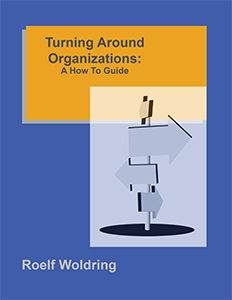
|
The Book on Amazon.com |
Turning around organizations is an art which takes both smarts and experience. Unfortunately, there are few books on the topic. This short book is the exception. Roelf Woldring has been involved in organizational turnarounds as a senior consultant and as the turnaround leader. He has dialogued with others who have been in these roles. In these pages, he distills his own and their experience into set of frameworks and guidelines that will be valuable to others engaged in organizational turnarounds.. This is a practical "how to guide" for change sponsors, turnaround leaders and the people inside and outside an organization undergoing turnaround. |
|
Investors, Turn Around Professionals |
| About Influencing Political Stakeholders and Social Issues (Go Back to Top of Page) |
| "Influencing Stakeholders: Making sure that those who count are aware that you count" |
Voice Over
|
Individuals working on projects and endeavors that need "support" from public figure stakeholders need to include explicit elements in their activities that get this needed support from these people. That requires understanding the "what counts" for such stakeholders, and framing benefits statements in this "stakeholder" language. It also means be very aware of when to send these "we count" messages, since innovative approaches impact differently on and are taken up at different times by "champions, early adopters, the early majority, the late majority and laggards".
This voice over has been accessed over 4000 times on SlideShare.
|
|
Everyone |
"If It is Broken, Fix It"
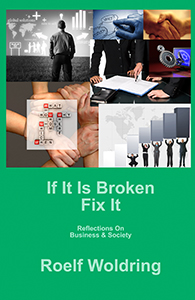
|
Kindle E-Books and Paper Back
(Amazon.com)
|
The blogs (essays) in this collection are intended to provoke thought and dialogue. They first appeared on www.roelfwoldring.wordpress.com.
These reflections on experience address topics such as:
- the real requirements for lasting organizational change,
- managing and measuring, or how to improve managing through realistic measuring,
- selecting senior organizational leaders,
- the fit between a business's nature and the abilities of its CEO
As well, there are essays on social issues such as:
- the marginalization of older workers in the workplace,
-
the FaceBook IPO,
- the Canadian elections,
... |
|
Everyone |















